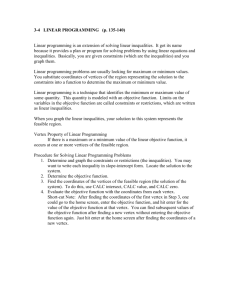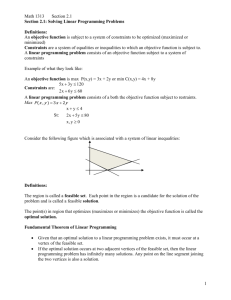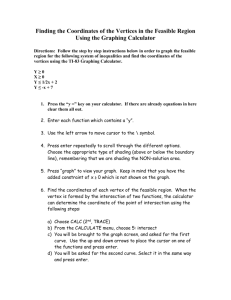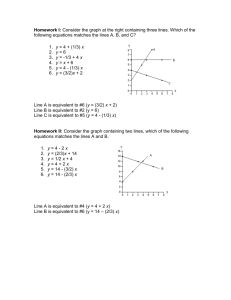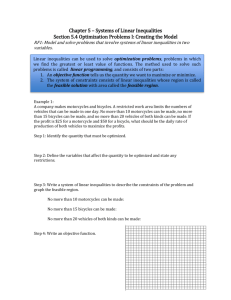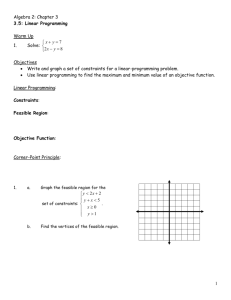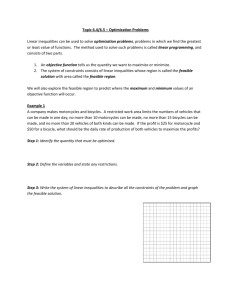3.2 Linear Programming I
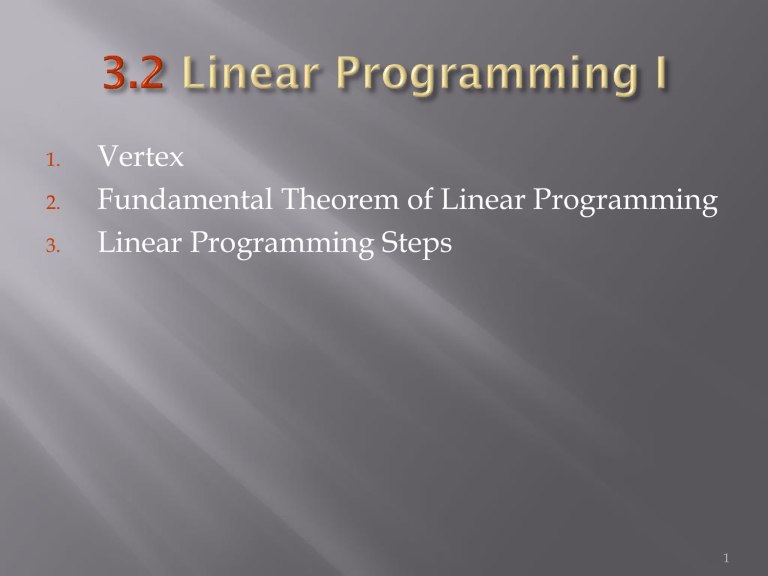
1.
2.
3.
Vertex
Fundamental Theorem of Linear Programming
Linear Programming Steps
1
The boundary of the feasible set is composed of line segments. The line segments intersect in points, each of which is a corner of the feasible set. Such a corner is called a vertex.
2
Find the vertices of
y < -2x + 32
y < -x + 18
y < -x/3 + 12
x > 0, y > 0.
(0,12)
(0,0)
(9,9)
(14,4)
(16,0)
3
Fundamental Theorem of Linear
Programming The maximum (or minimum) value of the objective function in a linear programming problem is achieved at one of the vertices of the feasible set.
The point that yields the maximum (or minimum) value of the objective function is called an optimal point.
4
Find the point which maximizes Profit = 80x +
70y for the feasible set with vertices (0,0), (0,12),
(9,9), (14,4) and (16,0).
Vertex
(0,0)
(0,12)
(9,9)
(14,4)
(16,0)
80 x + 70 y = Profit
80(0) + 70(0) = 0
80(0) + 70(12) = 840
80(9) + 70(9) = 1350
80(14) + 70(4) = 1400
80(16) + 70(0) = 1280
5
Step 1 Translate the problem into mathematical language.
A. Organize the data.
B. Identify the unknown quantities and define corresponding variables.
C. Translate the restrictions into linear inequalities.
D. Form the objective function.
6
Step 2 Graph the feasible set.
A. Put the inequalities in standard form.
B. Graph the straight line corresponding to each inequality.
C. Determine the side of the line belonging to the graph of each inequality. Cross out the other side.
The remaining region is the feasible set.
7
Step 3 Determine the vertices of the feasible set.
Step 4 Evaluate the objective function at each vertex. Determine the optimal point.
8
Rice and soybeans are to be part of a staple diet. One cup of uncooked rice costs 21 cents and contains 15 g of protein, 810 calories, and
1/9 mg of B
2
(riboflavin). One cup of uncooked soybeans costs 14 cents and contains 22.5 g of protein, 270 calories, and 1/3 mg of B
2
. The minimum daily requirements are 90 g of protein, 1620 calories and 1 mg of B
2
. Find the optimal point that will minimize cost.
9
Organize the data.
Rice Soybeans
Protein (g/cup) 15
Calories (per cup) 810
B
2
(mg/cup) 1/9
Cost (cents/cup) 21
22.5
270
1/3
14
Required level per day
90
1620
1
10
B. Identify the unknown quantities and define corresponding variables.
x = number of cups of rice per day
y = number of cups of soybeans per day
11
C. Translate the restrictions into linear inequalities.
Protein: 15x + 22.5y > 90
Calories: 810x + 270y > 1620
B
2
: (1/9)x + (1/3)y > 1
Nonnegative: x > 0, y > 0
12
D. Form the objective function.
Minimize the cost in cents:
[Cost] = 21x + 14y
13
A. Put the inequalities in standard form.
Protein:
Calories:
y > (-2/3)x + 4
y > -3x + 6
B
2
:
Nonnegative: x > 0
y > 0
y > (-1/3)x + 3
14
Example Step 2B
4
• B. Graph the straight 2 line corresponding to each inequality.
• 1. y = (-2/3)x + 4
• 2. y = -3x + 6
1
3
• 3. y = (-1/3)x + 3
• 4. x = 0
• 5. y = 0
5
15
Example Step 2C
• C. Determine the side of the line.
• y > (-2/3)x + 4
• y > -3x + 6
• y > (-1/3)x + 3
• x > 0
• y > 0 feasible set
16
Example Step 3
• Determine the vertices of the feasible set.
• x = 0 & y = -3x + 6: (0,6)
• y = -3x + 6 & y = (-2/3)x + 4:
• (6/7,24/7)
• y = (-2/3)x + 4 & y = (-1/3)x + 3:
• (3,2)
• y = (-1/3)x + 3 & y = 0: (9,0)
(0,6)
(6/7,24/7)
(3,2)
(9,0)
17
Determine the objective function at each vertex.
Determine the optimal point.
Vertex
(0,6)
(6/7,24/7)
Cost = 21x + 14y
21(0) + 14(6) = 84
21(6/7) + 14(24/7) = 66
(3,2) 21(3) + 14(2) = 91
(9,0) 21(9) + 14(0) = 189
The minimum cost is 66 cents for 6/7 cups of rice and 24/7 cups of soybeans.
18
The fundamental theorem of linear programming states that the optimal value of the objective function for a linear programming problem occurs at a vertex of the feasible set.
19
To solve a linear programming word problem, assign variables to the unknown quantities, translate the restrictions into a system of linear inequalities involving no more than two variables, form a function for the quantity to be optimized, graph the feasible set, evaluate the objective function at each vertex, and identify the vertex that gives the optimal value.
20
